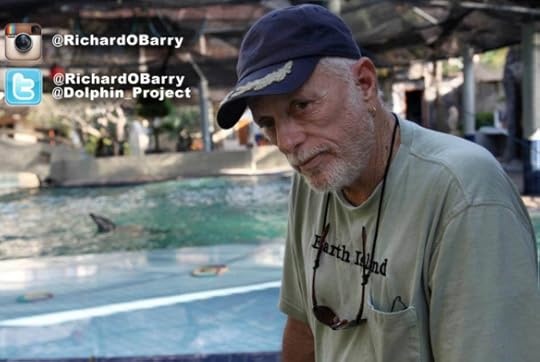Mark Caney's Blog, page 24
August 20, 2014
Airport runway decision on hold over dolphin habitat concerns

Prospects for a proposed third runway at Hong Kong International Airport seemed uncertain yesterday as environment advisers delayed their decision on whether to approve its environmental impact assessment study.
The advisers – from a subcommittee under the Advisory Council on the Environment – were concerned about how adequate and effective measures to mitigate the project’s impact on the threatened Chinese white dolphin habitat would be.
If the study is approved and the HK$130 billion project is given the go-ahead, some 650 hectares of prime habitat for the shrinking dolphin population would be lost to land reclamation for the third runway. Construction would last from 2016 to 2023.
The Airport Authority will respond in writing to further queries from the subcommittee, before another meeting on Monday for the advisers to deliberate their decision.
The subcommittee, which has spent 15 hours in three days grilling the authority’s officials on the environmental impact assessment study, met yesterday afternoon to discuss whether to recommend the advisory council to endorse the report.
But by the end of the meeting, it had still not drawn a conclusion on the city’s single most costly infrastructure project. The council has to submit its views by late next month to the environmental protection director, who will then decide whether to issue a work permit for the project.
A subcommittee member, who wanted to remain anonymous, said members at the meeting “freely expressed their opinions” about the report and what outstanding issues had to be further addressed by the authority.
“We haven’t come to the time to indicate our preference,” he said. “This takes time as … environmental impact assessment is a very complex issue.”
Another member said the subcommittee had a number of doubts on the mitigation measures to protect the dolphins during construction and what could be done to draw them back after the work is done. The authority’s replies had been unconvincing, he said.
The authority has so far agreed to set up a 2,400 hectare marine park to compensate for the habitat loss, but will build the park only after the runway is completed
Full story: South China Morning Post

August 19, 2014
Dolphin Talk Radio Interview With Star of The Cove, Ric O’Barry
On August 19 at 12 noon EST Dolphin Talk Radio will be interviewing Ric O’Barry star of, “The Cove” and director of the Ric O’Barry Dolphin Project. He will be discussing and taking questions on the dolphin drive in Taiji, Japan that begins September 1st, Japan Dolphins Day 2014, WAZA and JAZA’s involvement in Taiji, and the dolphins on display at the Mirage hotel in Las Vegas. Compose your questions for Ric, and be listening, and ready to call in when the lines open for questions! Please limit one question per caller. Dial USA: (424) 675-8287

August 12, 2014
August 6, 2014
Gene Responsible for Echolocation in Dolphins and Bats Found
E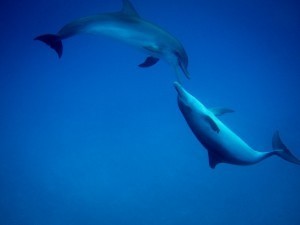 cholocation is used by both bats and dolphins, allowing them to navigate the world with the use of sound. Now, scientists have learned a bit more about this particular ability. They’ve found that prestin, a key gene responsible for hearing in mammals, independently evolved to play a critical role in the ultrasonic hearing range of animal sonar.
cholocation is used by both bats and dolphins, allowing them to navigate the world with the use of sound. Now, scientists have learned a bit more about this particular ability. They’ve found that prestin, a key gene responsible for hearing in mammals, independently evolved to play a critical role in the ultrasonic hearing range of animal sonar.
Previous studies have investigated the role of prestin in mammal hearing. This gene creates a protein found in the hair cells of the inner ear that contracts and expands rapidly to transmit signals that help the cochlea amplify sound waves to make hearing more sensitivity. Until now, though, scientists haven’t be sure about prestin’s role in echolocation.
Both toothed whales and echolocating bats can emit high frequency echolocation calls, which show substantial diversity in terms of their shape, duration and amplitude. These calls bounce off of objects which the animals then receive and analyze in order to navigate murky waters or dark nights. In order to understand this ability a bit better, the scientists finely dissected the function of the prestin protein from two sonar guided bats and the bottlenose dolphin. They then compared its function with non-sonar mammals.
After an evolutionary analyses of the prestin protein sequences, the scientists found that a single amino acid change in protein was the difference between sonar animals and non-sonar animals. More specifically, sonar mammals showed a change from threonine while non-sonar mammals showed a change in asparagine. In addition, the researchers identified four key amino acid differences among sonar mammals, which could contribute to their unique features.
Full story: Science World Report

August 5, 2014
Special offer to Kindle users
As a special thank you to followers of the Dolphin Way page, you have a chance to get a Kindle eBook version of Dolphin Way at a very low price. Previously the eBook version has sold at $4.39 in the US or £2.56 in the UK.
For one week only the book will be on sale for just $1.30 in the USA and £0.77 in the UK. This special offer will start on 5th August and end on 10th August. Follow this link to get the book: http://www.dolphin-way.com/the-book/dolphin-way-kindle/
July 22, 2014
Crumbling Wall Turned Into Powerful Tribute To Captive Orcas
Parisian graffiti artist Michael Beerens specializes in pieces that convey powerful messages, often containing haunting, beautiful portraits of animals.
Read full story with photos: The Dodo

July 17, 2014
Recent Dolphin Mortality Event Remains A Concern
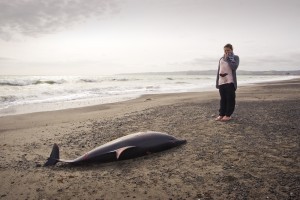 The National Aquarium’s Marine Animal Rescue Program (MARP) last week conducted its annual dolphin count along the coast in Ocean City and Assateagu, USA amid concerns over the stress of an unusual mortality event that has lingered on since last summer.
The National Aquarium’s Marine Animal Rescue Program (MARP) last week conducted its annual dolphin count along the coast in Ocean City and Assateagu, USA amid concerns over the stress of an unusual mortality event that has lingered on since last summer.
The National Aquarium Animal Rescue Program last Friday was joined by a large group of volunteers for the annual Maryland Dolphin Count and the numbers revealed a significant decline over the number counted during the 2013 event, but aquarium officials are not alarmed. Last Friday, around 50 volunteers of all ages came out between 8 a.m. and 11 a.m. to help record dolphin sightings at four locations, including the Assateague State Park day-use area and in Ocean City at 40th, 81st and 130th streets.
During the sessions, a total of 53 dolphins were counted at the four locations, which was a lower number than last year, likely due to limited visibility caused by fog. Last year, 113 dolphins were counted during the event, which is in the normal range. In 2012, just 31 dolphin sightings were recorded, representing the lowest total in recent years.
The annual dolphin count helps marine mammal specialists capture a snapshot at dolphin populations, reproduction rates and ocean health. Looking at the population numbers over the years can help determine the health of the coastal ecosystem as well as the abundance of prey. Prior to the annual dolphin count on the beach last Friday, a fundraiser was held at Seacrets on Thursday during which nearly $3,000 was raised for the National Aquarium Animal Rescue Program.
What is alarming for MARP officials and their colleagues up and down the east coast is the continued unusual mortality event that has plagued the dolphin population since about this time last year. Around mid-July 2013, the number of dolphin strandings up and down the coast from New York to Florida spiked dramatically, causing NOAA Fisheries to declare an unusual mortality event.
While there were some live strandings, most were found dead and often badly decomposed. The epidemic reached a crescendo late last summer and into the early fall, but National Aquarium Animal Rescue Program Stranding Coordinator Jennifer Ditmar said this week the mortality event has not abated and is still under investigation.
“The Unusual Mortality Event affecting bottlenose dolphins is still open and active unfortunately,” she said.
Full story: The Dispatch

July 11, 2014
July 10, 2014
Malnourished baby dolphin being nursed at Clearwater Marine Aquarium
A weak and malnourished baby dolphin that was rescued on a local beach on the Fourth of July is being nursed back to health at the Clearwater Marine Aquarium in the USA.
Beachgoers noticed a small, young dolphin struggling ashore Friday on Redington Beach. Aquarium workers helped the Florida Fish and Wildlife Conservation Commission in rescuing the animal, identified as a female Atlantic spotted dolphin.
Aquarium workers and volunteers are working to stabilize the 4-foot-long dolphin, providing it with medical care and fluids. Upon arriving at the facility Friday, the dolphin had little strength and couldn’t swim on its own. By Monday, it was more alert and was able to swim on its own for a few minutes at a time.
Experts believe that, based on the animal’s weight, it was without its mother for about a week.
“The medical team is pleased with the progress thus far, but there are several unknowns as we continue rehabilitation and treatment,” said David Yates, the aquarium’s CEO. “We want to thank the bystanders who reported the stranding to FWC for taking appropriate action, as stranded marine life are generally ill or injured and need immediate medical attention.”
The Clearwater aquarium has three dolphins in permanent residence — Winter, Hope and Nicholas. All three are Atlantic bottlenose dolphins that can’t be released into the wild due to the threat of injury or illness, the aquarium says.
“Dolphin calves run everything through their mother. When a young calf comes in without their mother, we become the adults that teach them how to survive,” said aquarium spokeswoman Amy Binder. “We don’t know what the future holds for this dolphin. Right now we’re just focused on treatment and rehabilitation.”
Source: Tampa Bay Times

July 8, 2014
Beautiful dolphin photos taken off coast of UK
The Maldives? Mauritius? In fact these stunning pictures of dolphins swimming through crystal clear turquoise waters were taken off Milford Haven.
A group of anglers on a fishing trip off the Welsh coast were stunned when the pod of around 50 dolphins surfaced close to their boat and put on a playful display.
The inquisitive mammals ducked and dived around the boat’s twin hulls and around it’s bow, frolicking for close to an hour.
The sun-kissed sea was so still and clear that the dolphins could be seen in all their glory, even well beneath the water, and trails of air bubbles followed behind them.
Angler Dave Lewis, 53, grabbed his camera and was able to capture a gallery of wonderful shots, an experience he said was ‘really intimate’ and highly ‘entertaining’.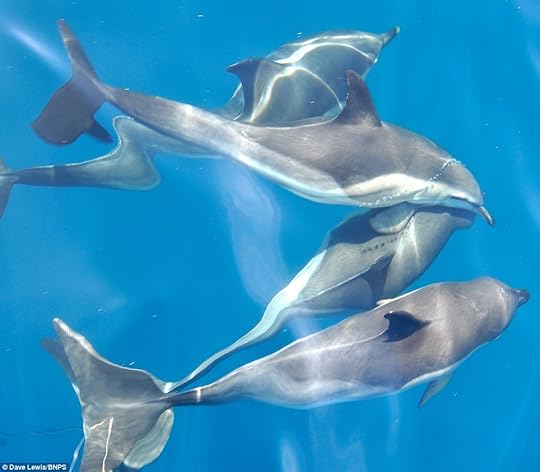
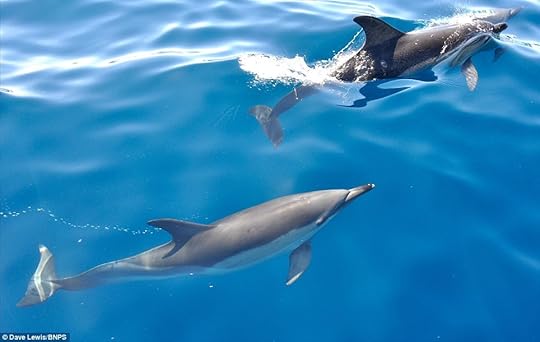
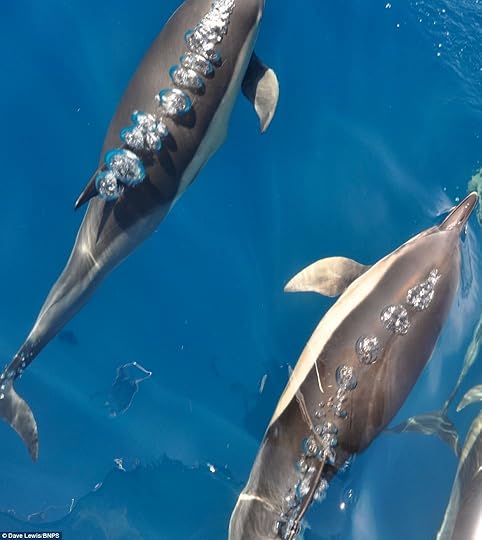
See more: MailOnline


